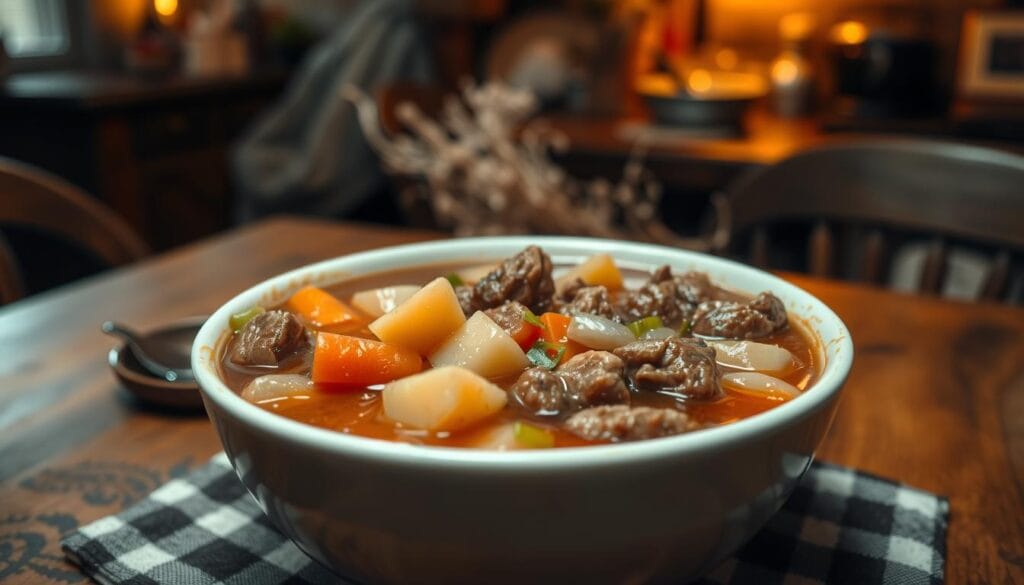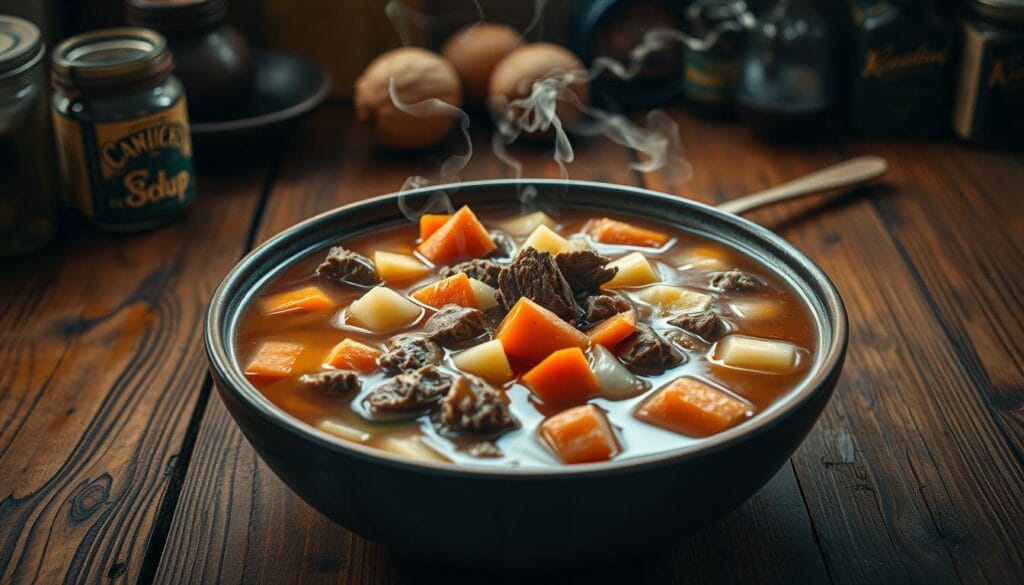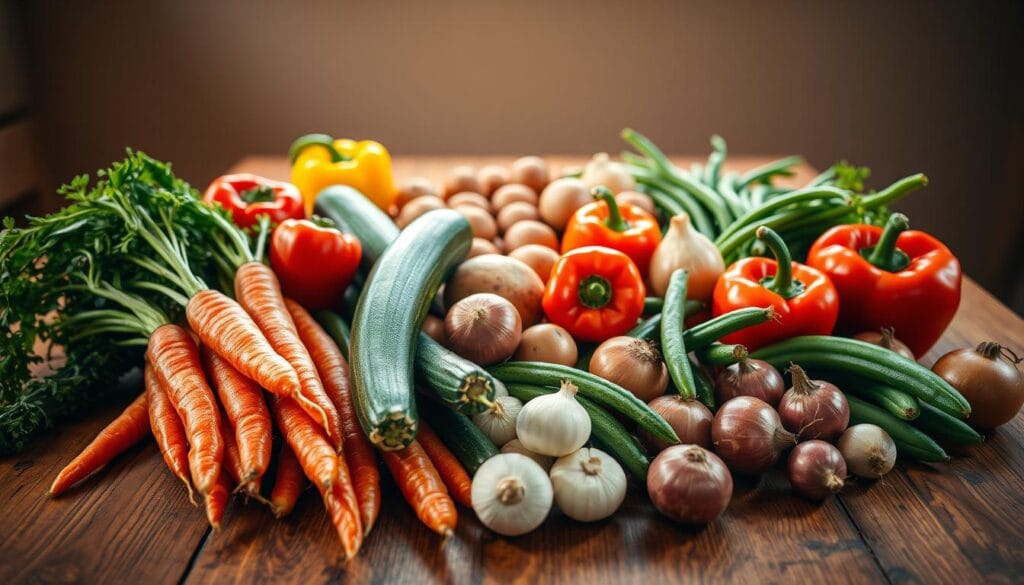Classic Old Fashioned Vegetable Beef Soup Recipe

Explore the world of classic American comfort food with this amazing old fashioned vegetable beef soup. It brings warmth to your kitchen and memories to your table. It captures the essence of traditional home cooking that generations have loved.
When it gets cold and you want a hearty meal, nothing is better than a steaming bowl of old fashioned vegetable beef soup. Each spoonful tells a story of family gatherings, winter evenings, and the simple pleasure of a perfectly crafted soup. It nourishes both body and soul.
This recipe is more than just ingredients. It’s about connecting to culinary traditions that have sustained families for decades. Whether you’re a seasoned cook or a kitchen novice, this comfort food will become a cherished part of your recipe collection.
Key Takeaways
- Discover an authentic old fashioned vegetable beef soup recipe
- Learn traditional cooking techniques passed down through generations
- Create a hearty meal that brings comfort and nostalgia
- Master the art of layering flavors in a classic soup
- Understand the cultural significance of home-cooked comfort food
Understanding the Heritage of Old Fashioned Vegetable Beef Soup
Vegetable beef soup is more than a meal. It’s a journey through American cooking traditions. This hearty dish brings together simple ingredients, telling a story of comfort and nourishment.

The roots of this classic soup are deep in American culinary history. Families across different regions have cherished their unique approaches to creating this warming dish. Each version reflects local ingredients and cooking styles.
Origins in Traditional American Cooking
Old fashioned vegetable beef soup emerged from practical necessity. Early settlers and rural families needed nutritious meals that could feed large families using available ingredients. The soup became a staple that maximized limited resources while delivering rich, classic flavors.
- Developed from frontier cooking techniques
- Used affordable, readily available ingredients
- Represented resourceful home cooking
Why This Recipe Has Stood the Test of Time
The enduring popularity of vegetable beef soup comes from its versatility and deep connection to home cooking. Grandma’s cooking methods have preserved this recipe through generations. This ensures its continued relevance in modern kitchens.
Regional Variations Across America
Different regions have embraced this soup with unique twists, showcasing the diversity of American culinary traditions. Some areas emphasize beef, while others highlight local vegetables.
| Region | Characteristic Variation |
|---|---|
| Midwest | Hearty beef-focused version |
| Southwest | Spicier profile with chili peppers |
| New England | Thick, stew-like consistency |
Each regional adaptation celebrates local ingredients while maintaining the soul of this beloved classic dish. The vegetable beef soup continues to warm hearts and connect families through its timeless appeal.
Essential Ingredients for Authentic Flavor

Making old-fashioned vegetable beef soup starts with picking the right ingredients. Your vegetable mix is key to making this dish unforgettable and healthy.
For a great soup, choose fresh, top-notch ingredients that go well together. Your veggie mix should have a mix of tastes, textures, and health benefits.
- Classic Root Vegetables:
- Carrots
- Potatoes
- Parsnips
- Hearty Green Vegetables:
- Celery
- Green beans
- Peas
When picking your veggies, think about what’s in season and what you like. Fresh veggies add bright colors and strong tastes to your meals.
| Vegetable | Nutritional Benefit | Flavor Profile |
|---|---|---|
| Carrots | High in Vitamin A | Sweet, earthy |
| Potatoes | Complex carbohydrates | Creamy, mild |
| Celery | Low calorie, high fiber | Crisp, slightly peppery |
Pro tip: Change up your veggies to keep your soup fresh and full of nutrients. Feel free to try new mixes that match your taste and diet.
Selecting and Preparing the Perfect Cut of Beef
Making a great beef stew begins with picking the right meat. The quality of your beef greatly affects the taste and texture of your soup. Knowing how to choose and prepare beef can turn a simple soup into a memorable dish.
Not all beef cuts are the same when it comes to soup. Some meats are better than others at creating the rich, comforting flavor you want.
Best Beef Cuts for Soup Making
- Chuck Roast: Ideal for beef stew with its rich marbling
- Short Ribs: Provides deep, intense flavor
- Bottom Round: Lean but still tender when slow-cooked
- Brisket: Develops incredible tenderness with long cooking
Proper Meat Preparation Techniques
Getting your beef ready right is key for flavor and tenderness. First, trim off any extra fat. Then, cut the meat into 1-inch cubes. This makes sure it cooks evenly and soaks up all the seasonings.
| Preparation Step | Purpose |
|---|---|
| Trim Fat | Reduce greasiness, concentrate flavor |
| Cut Uniform Cubes | Ensure even cooking |
| Season Before Browning | Develop deeper taste profile |
Tips for Maximum Tenderness
The secret to tender beef in your soup is patience. Slow cooking breaks down tough fibers, making the meat tender. Brown the meat before adding it to your soup to add rich, caramelized flavors.
Pro tip: Let the meat rest at room temperature for 30 minutes before cooking to ensure more even heating.
Fresh Vegetable Selection and Preparation Guide
Making a tasty vegetable medley is key to a great vegetable beef soup. The right vegetables can turn a simple soup into a meal that everyone loves.
When picking vegetables, aim for a mix of tastes and textures. Your perfect medley should have:
- Root vegetables: Carrots, parsnips, and turnips for sweetness
- Hearty greens: Kale or spinach for extra nutrition
- Aromatics: Onions and garlic for deep flavor
- Seasonal additions: Fresh produce for bright taste
Getting your vegetables ready is crucial for great flavor. Rinse them well and cut them into the same size. This ensures they cook evenly and add their own special taste to the soup.
Think about how long each vegetable takes to cook. Harder roots go in first, while softer greens come later to avoid mushiness. You want a medley that’s full of flavor and nutrients.
Pro tip: For the best taste, pick vegetables that are in season and local. They’ll add the most flavor and nutrients to your soup.
Creating the Perfect Soup Base
Making a great old fashioned vegetable beef soup starts with a solid soup base. Your homemade broths can turn a simple recipe into a true masterpiece. It’s a story of tradition and taste.
Homemade vs. Store-Bought Stock
The quality of your stock really matters for your soup’s flavor. Homemade broths have a depth and richness that store-bought can’t match.
- Homemade broths let you control sodium and ingredients
- Fresh stocks give more intense, real flavors
- Slow-simmered bone broths are more nutritious
Seasoning Secrets for Rich Flavor
Professional chefs say layering seasonings is crucial for memorable broths. Your choice of spices can make the whole soup better.
| Seasoning | Flavor Impact | Recommended Quantity |
|---|---|---|
| Dried Thyme | Earthy undertones | 1-2 teaspoons |
| Bay Leaves | Subtle aromatic depth | 2-3 whole leaves |
| Black Pepper | Warming heat | 1/2 teaspoon ground |
Building Layers of Taste
To make complex flavors, add ingredients wisely. Start by cooking onions and garlic to build a strong base. Then add your main ingredients.
“The secret to an extraordinary soup is patience and understanding how flavors develop.” – Chef Maria Rodriguez
Use top-notch ingredients and careful prep to make a vegetable beef soup that honors American cooking traditions.
Step-by-Step Cooking Instructions
Making the perfect old fashioned vegetable beef soup needs focus and a clear plan. Follow these cooking steps to make a delicious meal every time.
- Meat Preparation: Start by seasoning your beef chunks with salt and pepper. Brown the meat in a large pot with a bit of oil. This step locks in flavor and makes a rich base for your soup.
- Vegetable Chopping: While the meat browns, chop your vegetables into uniform pieces. This ensures even cooking and a consistent texture throughout the soup.
- Building the Base: Add diced onions, garlic, and your chosen vegetables to the pot. Stir and let them develop a deep, caramelized flavor.
The secret to a true old fashioned vegetable beef soup is layering flavors. Slowly add your liquid stock, letting the ingredients simmer and blend together. This slow, patient cooking is key to your hearty soup recipes.
| Cooking Stage | Time Required | Temperature |
|---|---|---|
| Meat Browning | 10-15 minutes | Medium-high heat |
| Vegetable Sautéing | 5-7 minutes | Medium heat |
| Soup Simmering | 1-2 hours | Low heat |
Keep your soup at a gentle simmer, stirring occasionally. The goal is to create a rich, flavorful broth. This broth turns simple ingredients into a comforting meal that honors traditional American cooking.
Old Fashioned Vegetable Beef Soup: Traditional Methods and Tips
Making the perfect slow cooker meals takes patience and knowing traditional cooking. Grandma’s cooking showed the beauty of slow preparation. It turns simple ingredients into warm, comforting dishes.
Slow cooking is more than just adding ingredients to a pot. Every step is important to make a soup full of flavor. It’s like cooking at home, but better.
Slow Cooking Benefits
Slow cooker meals are great for busy cooks. They let ingredients get rich flavors with little effort.
- Tenderizes tough meat cuts
- Develops deeper flavor profiles
- Reduces active cooking time
- Preserves nutritional value
Temperature Control Techniques
Keeping the right temperature is key to grandma’s cooking. Low heat makes meat tender and keeps veggies healthy.
- Start with medium-high heat to sear meat
- Reduce to low setting for extended cooking
- Maintain consistent temperature throughout
Timing Your Ingredients
Knowing when to add ingredients is crucial. Add delicate veggies last to keep them fresh and tender.
By using these slow cooking tips, you’ll make a soup that’s unforgettable. It’s a way to honor cooking traditions.
Storage and Reheating Guidelines
Keeping your vegetable beef soup fresh is key. It ensures your meals stay tasty and safe. The right storage keeps the soup’s flavors rich.
Here’s how to store it in the fridge:
- Cool the soup completely before storing
- Use airtight containers with tight-fitting lids
- Refrigerate within two hours of cooking
- Store for up to 3-4 days in the refrigerator
Freezing your soup is another great option. Pro tip: Leave about an inch of space at the top for expansion.
When reheating, pick methods that keep the soup’s texture and taste:
- Stovetop method: Reheat on medium-low heat, stirring occasionally
- Microwave option: Use a microwave-safe container and stir every 30 seconds
- Avoid rapid high-heat reheating to prevent vegetable and meat toughening
Vegetable beef soup is great for meal prep. By following these tips, your soup stays delicious and ready to eat anytime.
Serving Suggestions and Pairings
Your Old Fashioned Vegetable Beef Soup becomes unforgettable with the right sides. This dish is full of classic flavors. It needs sides that make it even more special.
Bread and Side Dish Options
Crusty sourdough or warm cornbread are great with your soup. Try toasting artisan bread and adding butter for a nice contrast. Roasted garlic mashed potatoes add a satisfying touch to your meal.
Garnishing Tips
Make your soup look great with simple garnishes. Chopped parsley, sour cream, or sharp cheddar cheese add flavor and color. Crispy bacon or homemade croutons add a fun crunch.
Wine Pairing Recommendations
If you love wine, try a medium-bodied red like Pinot Noir or Zinfandel. These wines match the soup’s meat and vegetable flavors well. A good wine choice can make your meal even better.
FAQ
What makes an old fashioned vegetable beef soup different from other soups?
This soup is special because of its hearty ingredients and slow-cooked taste. It has tender beef, fresh veggies, and a rich broth. These elements make it a true classic in American comfort food.
How long can I store leftover vegetable beef soup?
You can keep it in the fridge for 3-4 days in an airtight container. For longer, freeze it for up to 3 months. Make sure it’s cooled down first before freezing.
What are the best beef cuts for making this soup?
Choose cuts like chuck roast, beef stew meat, or short ribs. They get tender and flavorful during slow cooking. This makes the soup rich and delicious.
Can I make this soup in a slow cooker?
Yes, a slow cooker is great for this soup. It makes the meat tender and blends the flavors over 6-8 hours. It’s just like grandma used to make.
Are there any good vegetarian alternatives to this soup?
Yes, you can use mushrooms, lentils, or seitan instead of beef. Use a strong vegetable broth and keep the same mix of veggies. This way, you keep the soup’s classic taste and health benefits.
How can I make my soup more nutritious?
Add kale, spinach, or butternut squash for more nutrients. Use lean beef and beans for protein. Barley adds fiber. These changes make the soup healthier and more filling.
What bread pairs best with vegetable beef soup?
Try sourdough, rustic French baguettes, or homemade cornbread. They soak up the broth well and add a nice texture to your meal.https://www.recipeskic.com/

